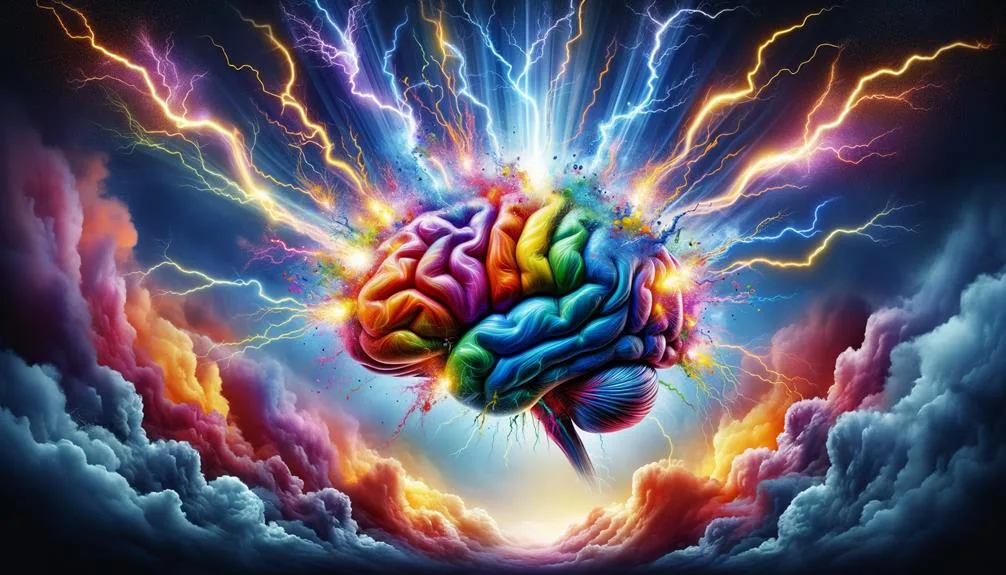Have you ever felt like your mind is a battleground, constantly bombarded by negative thoughts that hold you back from reaching your full potential? It's as if these thoughts have a tight grip on your mindset, making it difficult to break free and embrace a more positive outlook on life.
Well, the good news is that there are powerful tools available to challenge those negative thoughts and transform your mindset. In this discussion, we will explore these tools in detail, revealing how they can help you regain control over your thoughts and ultimately change the way you experience the world around you.
So, if you're ready to take the first step towards a more empowered and optimistic mindset, then keep reading to discover the transformative power of challenging negative thoughts.
Key Takeaways
- Automatic thinking plays a crucial role in our mental well-being, as negative automatic thoughts can contribute to a cycle of negativity and poor mental health outcomes.
- Positive automatic thoughts have the potential to offset the negative effects of negative automatic thoughts and stress, leading to higher levels of happiness.
- Cognitive restructuring is an effective technique for challenging and changing negative automatic thoughts, promoting healthier thinking patterns and improving mental well-being.
- CBT worksheets, such as 'Getting Rid of ANTS' and 'Thought/Feeling Record', can be helpful tools in identifying and challenging negative automatic thoughts.
Understanding Automatic Thinking
Understanding automatic thinking is crucial for gaining insight into the non-volitional thoughts that arise in response to our beliefs about ourselves and the world. Automatic thinking refers to the thoughts that pop into our minds without conscious effort.
These thoughts can be influenced by cognitive distortions and biases, which can lead to negative thoughts and perceptions. Cognitive distortions are patterns of thinking that distort our perception of reality, while cognitive biases are systematic errors in thinking that affect our decision-making process.
Differentiating Positive and Negative Automatic Thoughts

Differentiating between positive and negative automatic thoughts is essential for understanding how our mindset can impact our mental health and overall well-being.
Negative automatic thoughts, such as feeling up against the world or thinking you're no good, can have detrimental effects on your well-being. They contribute to a cycle of negativity and can lead to poor mental health outcomes.
On the other hand, positive automatic thoughts, like feeling supported by others or recognizing your strengths and achievements, can counteract the negative effects and improve your mental health.
Cognitive Restructuring Techniques

To effectively challenge negative thoughts and restructure your mindset, it is important to employ various cognitive restructuring techniques. Cognitive reframing and thought challenging techniques can help you replace negative automatic thoughts with more positive and balanced ones. Here are some effective techniques you can try:
| Technique | Description | Example |
|---|---|---|
| Labeling | Assigning a more accurate and realistic label to a negative thought | Instead of thinking "I'm a failure," reframe it as "I made a mistake, but I can learn from it." |
| Evidence Gathering | Collecting evidence that supports or contradicts the negative thought | When you think "Nobody likes me," gather evidence of times when people have shown kindness or friendship towards you. |
| Decatastrophizing | Examining the likelihood and consequences of the worst-case scenario | Instead of catastrophizing a situation, consider more realistic outcomes and their impact. |
| Perspective Taking | Stepping into someone else's shoes to gain a different viewpoint | Imagine how a supportive friend would view your situation and what advice they would give. |
CBT Worksheets for Challenging Thoughts

To effectively challenge negative thoughts and restructure your mindset, incorporating CBT worksheets can be a helpful and practical tool.
CBT techniques are designed to help you overcome negativity by identifying and challenging automatic negative thoughts. These worksheets provide a structured way to explore your thoughts and develop healthier thinking patterns.
The 'Getting Rid of ANTS' worksheet helps you understand the consequences of automatic thoughts and their impact on your mental well-being.
The 'Identifying ANTS' worksheet helps you recognize different types of negative thoughts and provides challenge questions to dispute them.
The 'Thought/Feeling Record' worksheet focuses on specific negative thoughts, their triggers, and consequences.
The 'Positive Replacement Thoughts' worksheet guides you in replacing negative thoughts with positive alternatives.
Lastly, the 'Questions for Challenging Thoughts' worksheet provides a list of questions to help you challenge and reframe negative thoughts.
Impact of Negative Automatic Thoughts on Mental Health

Negative automatic thoughts can significantly impact your mental health and contribute to a cycle of negativity. Here are three key points to consider:
- Negative automatic thoughts create a vicious cycle: When you constantly have negative thoughts, it becomes a self-perpetuating pattern. These thoughts can feed into each other, reinforcing negative beliefs about yourself and the world around you.
- Positive thinking can break the cycle: By challenging and replacing negative automatic thoughts with positive ones, you can disrupt the cycle of negativity. Positive thoughts have the power to improve your mental health and well-being.
- The benefits of positive thinking are real: Research has shown that higher levels of positive automatic thoughts are associated with increased happiness. By training yourself to think more positively, you can experience improved mental health outcomes and a more optimistic outlook on life.
Harnessing the Power of Positive Thinking

Harness the power of positive thinking to transform your mindset and improve your overall well-being. Cultivating optimism and implementing positive thinking techniques can have a profound impact on your mental health and happiness. By shifting your focus towards the positive aspects of your life, you can counteract the negative effects of automatic negative thoughts and stress.
To help you understand the significance of positive thinking, consider the following table:
| Positive Thinking Techniques | Benefits | Examples |
|---|---|---|
| Gratitude practice | Increases happiness, reduces stress | Writing down three things you are grateful for each day |
| Affirmations | Boosts self-confidence, promotes positive self-beliefs | Repeating positive statements about yourself |
| Visualization | Enhances motivation and goal attainment | Imagining yourself successfully achieving your goals |
Frequently Asked Questions
How Can Negative Automatic Thoughts Contribute to the Development of Depression?
Negative automatic thoughts can contribute to the development of depression by shaping your perception of yourself, experiences, and the future. These thoughts can create a cycle of negativity and lead to poor mental health outcomes.
What Are Some Examples of Positive Automatic Thoughts and How Do They Impact Mental Well-Being?
What are some examples of positive automatic thoughts and how do they impact mental well-being? Positive affirmations, like feeling supported, recognizing strengths, and being optimistic about the future, can counteract negativity and improve mental health. The benefits of positive thinking are real.
Are There Any Specific Techniques or Strategies for Challenging and Replacing Negative Automatic Thoughts?
There are various techniques and strategies you can use to challenge and replace negative automatic thoughts. Some examples include cognitive restructuring, exposure therapy, role-playing, mindfulness, and using CBT worksheets. These methods can help you develop healthier thinking patterns and improve your mental well-being.
How Can Cognitive Restructuring Help Improve Mental Well-Being and Promote Healthier Thinking Patterns?
Cognitive restructuring helps you improve mental well-being by challenging negative thoughts. It promotes healthier thinking patterns and replaces negative thoughts with positive alternatives. CBT worksheets and strategies for positive thinking are effective tools for this transformation.
Can You Provide Some Examples of the Types of Questions Used in CBT Worksheets for Challenging Negative Thoughts?
CBT worksheets for challenging negative thoughts include questions like: "What evidence supports this negative thought?", "What alternative explanation is there?", and "How would you advise a friend in the same situation?"
Conclusion
Congratulations! You've taken the first step towards breaking free from the grip of negative thoughts and transforming your mindset.
By challenging those automatic negative thoughts, you're unlocking the power of positive thinking and paving the way for a brighter future.
Embrace the irony of this journey, as you harness the tools and techniques shared in this article.
Remember, you have the power to reshape your thoughts and cultivate a more positive outlook on life.
So go forth and conquer those negative thoughts, for a happier and more fulfilling life awaits you.

